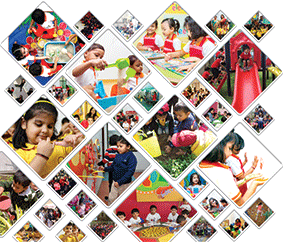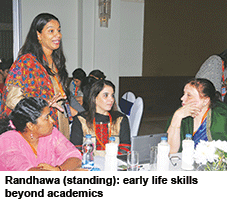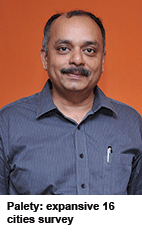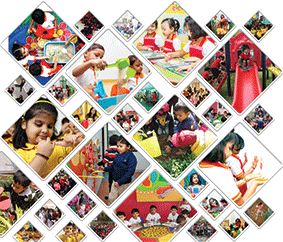EducationWorld India Preschool Rankings 2016
For the seventh annual EW India Preschool Rankings 2016 survey, over 100 field researchers of the Delhi-based C fore interviewed 7,898 parents, principals and teachers in 16 cities countrywide to rate and rank owned/proprietary and franchised pre-primaries separately -Dilip Thakore & Summiya Yasmeen
 Readers of this sui generis publication are familiar with the lament that education — universally accepted as the building block of national development — has been severely under-funded, under-governed and neglected in post-independence India.
Readers of this sui generis publication are familiar with the lament that education — universally accepted as the building block of national development — has been severely under-funded, under-governed and neglected in post-independence India.
The price of sustained neglect of education has been heavy. The country’s population has tripled since independence, industrial and agriculture productivity measured in terms of output per employee and crop yields per hectare is arguably the lowest worldwide, sanitation and public healthcare standards are rock-bottom and with only 74 percent of the population literate, 21st century India grudgingly hosts the worlds largest number of wholly illiterate citizens (300 million). Despite all these evils spreading across the landscape, the annual outlay for public education (Centre plus states) has averaged a mere 3.5 percent of GDP for the past 69 years after the newly-independent nation was promised an exciting “tryst with destiny” on August 15, 1947. Against this, annual expenditure on public education in countries around the world averages 5 percent with the developed OECD nations routinely spending the equivalent of 7-10 percent of GDP for educating their children and youth.
And if you are convinced as we are, that resources invested for the education and development of the worlds largest child population (480 million) are insufficient, provision for early childhood care and education (ECCE) for the country’s 164 million children under five years of age is even less so. The number of infants who receive professionally administered early childhood care and education in the nations estimated 300,000 private pre-primary schools aggregates a mere 10 million. Of the remaining 154 million, 84 million children are provided rudimentary ECCE in the country’s 1.34 million anganwadis — essentially nutrition centres for newly born infants and lactating mothers — established by the Central government under its Integrated Child Development Services (ICDS) programme promoted in 1975.
Although in recent years, government spokespersons have been paying lip service to providing early childhood education in the country’s 1.34 million anganwadis, its the last priority of these severely understaffed and ill-maintained centres. According to a study conducted last year (2015) by the NITI Aayog (an advisory council which has replaced the Soviet-style Planning Commission that was abolished by the newly-elected BJP-led NDA government in 2014), 51.8 percent of the country’s AWCs (anganwadi centres) suffer poor hygiene and sanitation conditions. Significantly these centres and the ICDS programme are administered by the Union ministry of women and child development (WCD). Despite the WCD ministry having chalked up a miserable record — a staggering 48.5 percent of India’s children below age five are severely under-nourished and in danger of stunting — repeated calls by educationists to transfer the ICDS programme to the Union human resource development (aka education) ministry have fallen on unheeding ears.
 Following breakthrough neuro-science research in the early years of the new millennium, its well-established that children’s brains are almost fully developed by the time they attain eight years of age. Therefore, there’s an emerging global consensus that ECCE is of vital importance for developing human capital. According to Nobel laureate (2000) economist Dr. James Heckman, a dollar invested in ECCE is a much better investment than dollars invested later in the education continuum in terms of social and economic returns to society. Little wonder that the industrially advanced OECD countries — and China — are allocating ever greater percentages of their annual education budgets to early years education and in vanguard countries such as Finland and Sweden, pre-primary teachers are paid more than primary-secondary school faculty.
Following breakthrough neuro-science research in the early years of the new millennium, its well-established that children’s brains are almost fully developed by the time they attain eight years of age. Therefore, there’s an emerging global consensus that ECCE is of vital importance for developing human capital. According to Nobel laureate (2000) economist Dr. James Heckman, a dollar invested in ECCE is a much better investment than dollars invested later in the education continuum in terms of social and economic returns to society. Little wonder that the industrially advanced OECD countries — and China — are allocating ever greater percentages of their annual education budgets to early years education and in vanguard countries such as Finland and Sweden, pre-primary teachers are paid more than primary-secondary school faculty.
“Early childhood care and education is of prime importance because it endows valuable skills beyond academics such as sharing, empathy and cooperation, and teaches youngest children to become engaged with the process rather than product of work. Therefore it prepares children not just for primary education as is popularly believed, but for life. Unfortunately, insufficient attention is paid to ECCE in India where its widely equated with baby-sitting and premature teaching of the 3 Rs when ideally, it should provide youngest children opportunities to explore the world through constructive play in well-designed environments”, says Amrita Randhawa, a psychology graduate of Mt. Holyoke College, Massachusetts with a Masters from the Harvard School of Education and several years of teaching experience at the Wellesley College Study Center, Boston and The Teacher Foundation, Bangalore. Currently Randhawa is the Bangalore-based head of faculty at the Asian International College (India) — a subsidiary of AIC, Singapore — which has pioneered provision of globally-benchmarked teacher training services to early childhood educators in the subcontinent.
 But even if the Central and state governments and the academy are yet to fully appreciate the critical importance of professionally administered ECCE on a mass scale, your editors became aware of this national imperative in the noughties under the influence of the US-based brothers Lowell and Michael Milken, promoter-trustees of the Los Angeles-based Milken Institute which has made major breakthroughs in healthcare and education research. The Milken brothers not only invested equity in this then floundering publication which received minimal support from the lip service champions of Indian industry, but also encouraged your editors to stage the country’s first Early Childhood Education Global Conference in 2010 by providing sponsorship and globally-renowned experts from their 2,000-strong Kinder Care chain of preschools in the US.
But even if the Central and state governments and the academy are yet to fully appreciate the critical importance of professionally administered ECCE on a mass scale, your editors became aware of this national imperative in the noughties under the influence of the US-based brothers Lowell and Michael Milken, promoter-trustees of the Los Angeles-based Milken Institute which has made major breakthroughs in healthcare and education research. The Milken brothers not only invested equity in this then floundering publication which received minimal support from the lip service champions of Indian industry, but also encouraged your editors to stage the country’s first Early Childhood Education Global Conference in 2010 by providing sponsorship and globally-renowned experts from their 2,000-strong Kinder Care chain of preschools in the US.
Since then, this publication has staged six early childhood international conferences and also initiated an annual exercise of rating and ranking the country’s small minority of pre-primary schools with the objective of encouraging the replication and growth of top-ranked preschools across the country. In recent years, the annual EducationWorld Early Childhood Global Conference has also received the support of John Woodward, the promoter-chairman of the UK-based Busybees Group Plc, which owns over 360 highly-respected pre-primaries in the UK, 60 in South-east Asia, as also the Asian International College, Singapore.
This year’s annual EW ECE Global Conference has been downgraded to a national conference because the quality and practice gap between pre-primary education in the developed OECD, progressive South-east Asian countries and India is so wide that several well-informed indigenous ECCE experts complained that the infrastructure, government and parental support that early childhood educators in developed countries take for granted are novel and unimaginable for Indian preschool principals, teachers and professionals.
Accordingly, the EW Early Childhood Education National Conference is scheduled to be held at the ITC Gardenia Hotel, Bangalore (aka Bengaluru) on January 21, 2017. It will discuss and debate best ECCE practices in the Indian subcontinent. All ECCE professionals, experts and academics interested in attending are requested to register on www.educationworld.in.
Meanwhile as per established practice, as a precursor to the forthcoming EW ECE National Conference aforesaid, your editors commissioned the highly-reputed Delhi-based market research and opinion polls company Centre for Forecasting and Research Pvt. Ltd (C fore) to conduct a nationwide survey to rate and rank the most respected pre-primaries/preschools in 16 large and smaller cities countrywide in which there’s sufficient awareness and patronage of professionally administered ECCE.
To eliminate apples-with-oranges type comparisons, standalone proprietary and franchised pre-primaries are separately ranked inter se. Last years experiment of also rating and ranking pre-primaries of composite K-12 schools in a separate category has been abandoned because the rankings to all intents and purposes were replicas of our annual EW India School Rankings published every September.
“The perceptual survey was conducted in 16 cities, viz, Delhi, Mumbai, Chennai, Kolkata, Bangalore, Hyderabad, Pune, Ahmedabad, Gurgaon, Noida, Bhubaneswar, Chandigarh, Ghaziabad, Jaipur, Kochi and Lucknow. Over 100 C fore researchers conducted the survey in these cities. The repondents sample comprised SECA (socio-economic category ‘A) parents with at least one child enroled in a pre-primary school and ECCE principals and teachers in each city. In all, a total of 7,898 individuals were interviewed countrywide”, says Premchand Palety, an alumnus of the top-ranked Panjab University and the Fore School of Management, Delhi and promoter-director of C fore (estb. 2000).
Every respondent was shown the list of pre-selected pre-primaries in their city, and asked to rate them on ten parameters of pre-primary excellence — competence of faculty, infrastructure, individual attention to students, value for money, leadership/management quality, parental involvement, innovative teaching, safety and hygiene and facilities provided for special needs children — on a ten point scale, except that the critical parameter of competence of teachers was given double weightage. Institutions assessed by less than 30 persons haven’t been included in the league tables. “The scores awarded by respondents under each parameter were aggregated and preschools in each city were ranked in descending order according to their total scores”, explains Palety.
In the pages following, we present pre-primary/preschool league tables for 16 cities in which the most well-known preschools are rated and ranked under each parameter and also awarded overall ranking according to total scores. It is our hope and aspiration that educators will draw inspiration from these league tables, the outcome of an elaborate and professionally-administered process, and replicate and multiply the number of ECCE schools across the country. We also believe these league tables will enable young parents to choose the most appropriate pre-primaries for their children to give them a good start in life.
With Autar Nehru (Delhi); Baishali Mukherjee (Kolkata); Dipta Joshi (Mumbai); Swati Roy (Noida) & Paromita Sengupta (Bangalore)
















Add comment